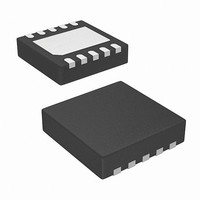ISL6341ACRZ Intersil, ISL6341ACRZ Datasheet - Page 7

ISL6341ACRZ
Manufacturer Part Number
ISL6341ACRZ
Description
IC CTRLR SYNC BUCK PWM 10-TDFN
Manufacturer
Intersil
Datasheet
1.ISL6341CRZ.pdf
(17 pages)
Specifications of ISL6341ACRZ
Pwm Type
Voltage Mode
Number Of Outputs
1
Frequency - Max
660kHz
Duty Cycle
75%
Voltage - Supply
4.5 V ~ 14.4 V
Buck
Yes
Boost
No
Flyback
No
Inverting
No
Doubler
No
Divider
No
Cuk
No
Isolated
No
Operating Temperature
0°C ~ 70°C
Package / Case
10-TDFN Exposed Pad
Frequency-max
660kHz
Lead Free Status / RoHS Status
Lead free / RoHS Compliant
Available stocks
Company
Part Number
Manufacturer
Quantity
Price
Part Number:
ISL6341ACRZ
Manufacturer:
INTERSIL
Quantity:
20 000
.
From t1, there is a nominal 4ms delay, which allows the VCC
pin to rise. At the same time, the LGATE/OCSET pin is
initialized by disabling the LGATE driver and drawing I
(nominal 10µA) through R
will represent the OCSET trip point for the OCP sample and
hold operation. The sample and hold uses a digital counter and
DAC (to save the voltage so the stored value does not degrade)
for as long as the V
Protection (OCP)” on page 8 for more details on the equations
and variables. Upon the completion of sample and hold at t2,
the soft-start operation is initiated (around 0.8ms delay to t3),
and then around 4ms for the output voltage to ramp up (0% to
100%) between t3 and t4. The PGOOD output is allowed to go
high at t4 if VOS (and thus V
window.
Soft-Start and Pre-Biased Outputs
Functionally, the soft-start internally ramps the reference on the
non-inverting terminal of the error amp from zero to 0.8V in a
nominal 4ms. The output voltage will thus follow the ramp, from
zero to final value, in the same 4ms. The ramp is created
digitally, so there will be small discrete steps. There is no simple
way to change this ramp rate externally, as it is fixed by the
300kHz (or 600kHz) switching frequency (and the ramp and
delay time is the same for both frequencies).
After an initialization period (t2 to t3), the error amplifier
(COMP/EN pin) is enabled, and begins to regulate the
converter’s output voltage during soft-start. The oscillator’s
triangular waveform is compared to the ramping error amplifier
voltage. This generates PHASE pulses of increasing width that
charge the output capacitors. When the internally generated
soft-start voltage exceeds the reference voltage (0.8V), the
soft-start is complete, and the output should be in regulation at
the expected voltage. This method provides a rapid and
controlled output voltage rise; there is no large in-rush current
charging the output capacitors. The entire start-up sequence
from POR typically takes 9ms; 5ms for the delay and OCP
sample, and 4ms for the soft-start ramp.
GND>
GND>
GND>
GND>
FIGURE 2. LGATE/OCSET AND SOFT-START OPERATION
t0
0.7V
t1
LGATE/OCSET
CC
COMP/EN (0.25V/DIV)
0.25V/DIV
4.0ms
is above V
OCSET
OUT
t2
0.8ms
7
. This sets up a voltage that
) is within the PGOOD
t3
POR
ISL6341, ISL6341A, ISL6341B, ISL6341C
. See “Overcurrent
SWITCHING
4.0ms
STARTS
LGATE
PGOOD (2V/DIV)
t4
(0.25V/DIV)
V
OCSET
OUT
Figure 3 shows the normal V
begins at t0, and the output ramps between t1 and t2. If the
output is pre-biased to a voltage less than the expected
value (as shown by the magenta curve), the ISL6341x will
detect that condition. Neither MOSFET will turn-on until the
soft-start ramp voltage exceeds the output; V
seamlessly ramping from there.
There is a restriction for the pre-bias case; if the pre-biased
V
discharged, and will not be able to restart. For example, if
V
5V, then the voltage left on the boot cap (to UGATE) will not
be able to turn on the upper FET. The simple solution here is
to use the 12V for V
diode - Vth upper FET > V
If the output is pre-biased to a voltage above the expected
value (as in the red curve), neither MOSFET will turn-on until
the end of the soft-start, at which time it will pull the output
voltage quickly down to the final value. Any resistive load
connected to the output will help pull-down the voltage (at
the RC rate of the R of the load and the C of the output
capacitance).
One exception to the overcharged case is if the pre-bias is
high enough to trip OV protection (>1V on VOS); then
LGATE will pulse to try to pull V
latched in this mode until V
If the V
the boot diode) is from a different supply that comes up after
V
voltage ramp. Once the undervoltage protection is enabled
(at the end of the soft-start ramp), the output will latch off.
Therefore, for normal operation, V
enough before or with V
alternative is add sequencing logic to the COMP/EN pin to
delay the soft-start until the V
(see “Input Voltage Considerations” on page 12).
GND>
GND>
GND>
OUT
IN
CC
= 12V, V
, the soft-start would start its cycle, but with no output
is greater than V
IN
V
V
V
to the upper MOSFET drain (or the V
OUT
OUT
OUT
FIGURE 3. SOFT-START WITH PRE-BIAS
OUT
PRE-BIASED
OVERCHARGED
NORMAL
t0
= 8V and prebiased to 6V, and V
GD
GD
. The guideline is to make V
CC
, then the boot cap may get
OUT
CC
. If this is not possible, then the
t1
OUT
IN
power is toggled.
OUT
to prevent this condition.
(and V
curve in blue; initialization
IN
lower. The IC will remain
(and V
GD
) supply is ready
GD
OUT
) must be high
GD
December 2, 2008
t2
starts
GD
voltage to
GD
is only
FN6538.2
-













